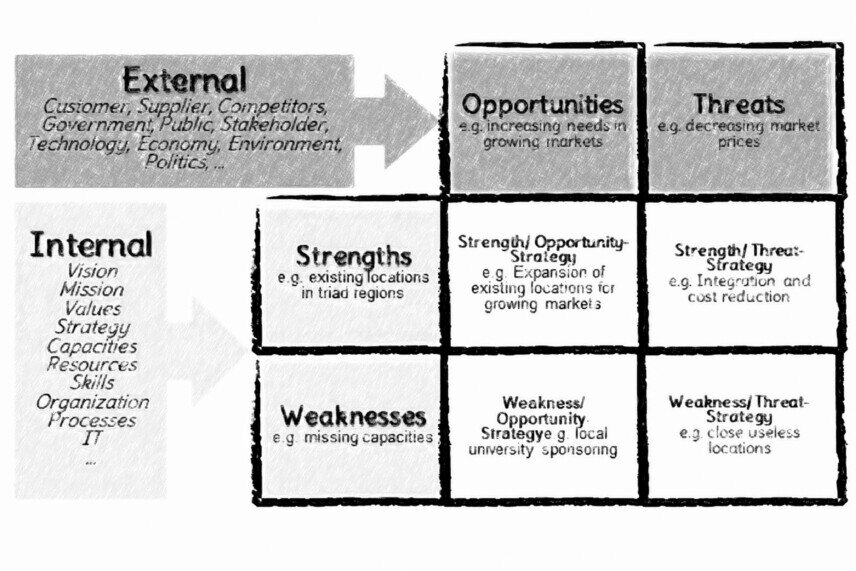SWOT-Analyse
SWOT is the abbreviation for Strength, Weakness, Opportunity, and Threat. It offers an effective way to identify action fields and to plan measures. For this purpose, internal and external elements are collected and evaluated as positive (strengths/opportunities) or negative (weaknesses/threats). The discussion of the elements in teams requires time to reach a joint evaluation. The resulting four lists constitute the SWOT portfolio, where identified strategies are collected.
SWOT is divided into internal (strength weakness), external (opportunity/threat) as well as resulting strategy fields (i.e., strengths/opportunity, strengths/threats, weaknesses/opportunities, and weaknesses/threats strategy).

- Intern
Internal elements are, in principle, neutral and become strengths or weaknesses through the evaluation of the individual situation. Possible strengths/weaknesses are, among other things, quality, variety, prices, resources, culture, and organization.
- Strengths
can be determined by the following questions: What are our substantial three strengths? Which three strengths are particularly emphasized by customers, business partners, and the public? What are we particularly proud of?
- Weaknesses
can be determined by the following questions: In which three areas do we feel weak? Which three aspects business partners and the public do criticize repeatedly? Which three outcomes are embarrassing for us? - Extern
External elements are, in principle, neutral and become opportunities and threats by the evaluation in the individual situation. Possible opportunities/threats are, among other things, market, industries, product segments, job market, economic situation, political situation. - Opportunities
can be determined by the following questions: Which three changes offer possibilities for improvement? Which three trends are promising?
- Threats
can be determined by the following questions: Which three threats keep us busy for a longer time? Which three aspects threaten us in the future? Which three strategies do competitors pursue? - Strategy fields
Strategy fields describe the measures that are needed as reaction to the internal and external elements. - Strengths/opportunities strategy
In this area, measures are defined that ensure favorable basic conditions on a long-term basis. It can be determined by the following questions: How can we use our strengths in other areas? How do we develop three additional strengths for the use of the opportunities?
- Strengths/threats strategy
In this area, measures are defined that use the existing strengths despite the threats. It can be determined with the following questions: How can we develop three additional strengths to overcome the threats? How can threats be minimized?
- Weaknesses/opportunities strategy
In this area, measures are defined that avoid existing weaknesses that impede the opportunities. It can be determined by the following questions: How do we use opportunities despite weaknesses? How do we extend our strategy for the use of new opportunities?
- Weaknesses/threats strategy
In this area, measures are defined that avoid disadvantages and threats that endanger success. It can be determined with the following questions: How do we avoid dramatic disadvantages from the weaknesses and threats?

